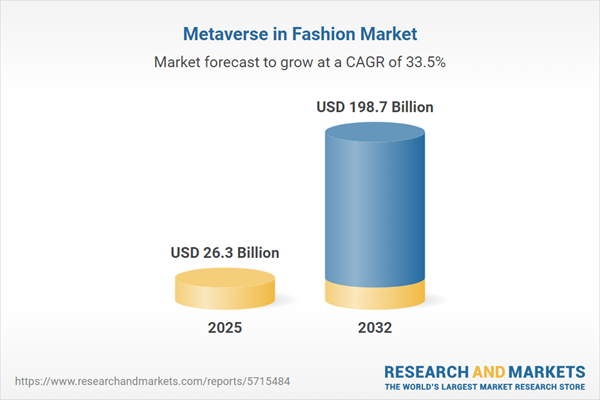Speak directly to the analyst to clarify any post sales queries you may have.
The metaverse in fashion market is transforming how brands deliver value to consumers, blending immersive technologies with retail to reshape the customer journey. Senior decision-makers must evaluate evolving digital platforms and interaction models as dynamic influences on competitive strategy and long-term growth.
Market Snapshot: Metaverse in Fashion Market
In 2024, the metaverse in fashion market reached USD 19.74 billion with a projected rise to USD 26.30 billion by 2025, propelled by a CAGR of 33.45% through 2032 and an anticipated value of USD 198.70 billion. This growth is supported by integration between digital environments and fashion, rising user digital literacy, and a surge in demand for engaging online experiences. Strategic investment from both fashion and technology leaders is accelerating virtual commerce, expanding global reach, and enhancing digital engagement at scale. Organizations are leveraging new platforms to capture commercial opportunities, optimize efficiency, and strengthen positions within a fast-evolving global fashion ecosystem.
Scope & Segmentation
- Component: Hardware, software, managed services, and professional services address diverse needs for designing and deploying virtual environments tailored for fashion brands and retailers.
- Technology: 3D visualization, augmented reality, mixed reality, and virtual reality form the foundation for lifelike digital retail experiences and interactive showcases.
- Application: Virtual clothing, digital events, online marketplaces, and immersive stores enable brands to innovate merchandising, increase product access, and enhance consumer engagement.
- End User: Solutions are designed for individual consumers as well as luxury and mass market brands, supporting customized engagement and adaptability to rapidly shifting digital behaviors.
- Deployment Mode: Cloud-based and on-premises models offer scalable, secure, and efficient platforms suitable for various operational preferences and business scales.
- Geography: Core markets include the Americas, Europe, Middle East & Africa, and Asia-Pacific, with regional adoption shaped by local technology trends and innovation readiness, while the U.S., U.K., and China act as primary innovation hubs.
- Companies Profiled: Leading companies such as Roblox Corporation, Meta Platforms, Inc., Epic Games, NVIDIA, Unity Software, Microsoft, Adobe, Nike, adidas, and Animoca Brands shape industry standards and competitive benchmarks by advancing digital fashion capabilities.
Key Takeaways for Senior Decision-Makers
- Immersive storytelling and interactive digital platforms are fostering deeper connections between fashion brands and consumers, leading to enhanced engagement across digital touchpoints.
- Visualization platforms and extended reality tools offer brands the opportunity to build differentiated digital identities and deliver unique online retail experiences.
- Co-creation features, such as virtual fittings and collaborative sessions, are increasing consumer loyalty and supporting streamlined development cycles focused on customer preferences.
- Young, digitally literate consumers are accelerating adoption, making it vital for brands to invest in localized content and strategy adaptation for broader market appeal.
- Secure, modular architectures enable brands to personalize offerings, protect sensitive information, and ensure operational efficiency across multi-regional deployments.
- Collaborative partnerships between technology providers and creative teams are driving faster business responses and maintaining high engagement levels, ensuring brands can compete amid rapid change.
Tariff Impact on the Fashion Metaverse
Recent shifts in U.S. hardware tariffs are altering cost structures across the fashion metaverse supply chain. To maintain profitability and flexibility, brands are diversifying sourcing, moving toward local assembly, and prioritizing cloud-based solutions. This approach strengthens compliance, bolsters product consistency, and deepens customer engagement, improving overall supply chain resilience in a complex digital environment.
Methodology & Data Sources
This analysis draws on expert interviews, executive feedback, and virtual focus groups. Live virtual observation, detailed competitor benchmarking, regulatory reviews, and investment monitoring are coupled with key industry literature review to ensure actionable, reliable findings for strategic leadership.
Why This Report Matters
- Delivers actionable insight on key technology trends, regulatory developments, and evolving consumer preferences shaping the metaverse in fashion market.
- Equips leaders to address supply chain risks, refine sourcing strategies, and manage digital risk as virtual commerce becomes increasingly central to global fashion operations.
- Supports brands and technology partners in building resilient, adaptive digital operations for sustainable growth as the competitive landscape evolves.
Conclusion
Digital transformation at the intersection of fashion and technology is unlocking new opportunities and drivings innovation. This report provides the guidance senior leaders need to succeed and adapt within an evolving metaverse-driven marketplace.
Additional Product Information:
- Purchase of this report includes 1 year online access with quarterly updates.
- This report can be updated on request. Please contact our Customer Experience team using the Ask a Question widget on our website.
Table of Contents
3. Executive Summary
4. Market Overview
7. Cumulative Impact of Artificial Intelligence 2025
List of Figures
Samples

LOADING...
Companies Mentioned
The key companies profiled in this Metaverse in Fashion market report include:- Roblox Corporation
- Meta Platforms, Inc.
- Epic Games, Inc.
- NVIDIA Corporation
- Unity Software Inc.
- Microsoft Corporation
- Adobe Inc.
- Nike, Inc.
- adidas AG
- Animoca Brands Corporation Limited
Table Information
| Report Attribute | Details |
|---|---|
| No. of Pages | 185 |
| Published | October 2025 |
| Forecast Period | 2025 - 2032 |
| Estimated Market Value ( USD | $ 26.3 Billion |
| Forecasted Market Value ( USD | $ 198.7 Billion |
| Compound Annual Growth Rate | 33.4% |
| Regions Covered | Global |
| No. of Companies Mentioned | 11 |









